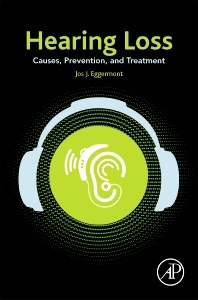Hearing Loss Causes, Prevention, and Treatment
Auteur : Eggermont Jos J.

Hearing Loss: Causes, Prevention, and Treatment covers hearing loss, causes and prevention, treatments, and future directions in the field, also looking at the cognitive problems that can develop.
To avoid the ?silent epidemic of hearing loss, it is necessary to promote early screening, use hearing protection, and change public attitudes toward noise. Successful treatments of hearing loss deal with restoring hearing sensitivity via hearing aids, including cochlear, brainstem, or midbrain implants. Both the technical aspects and effects on the quality of life of these devices are discussed.
The integration of all aspects of hearing, hearing loss, prevention, and treatment make this a perfect one-volume course in audiology at the graduate student level. However, it is also a great reference for established audiologists, ear surgeons, neurologists, and pediatric and geriatric professionals.
Part I: The Basics1. Hearing Basics2. Brain Plasticity and Perceptual Learning3. Multisensory Processing
Part II: The Problem4. Hearing Problems5. Types of Hearing Loss
Part III: The Causes6. Causes of Acquired Hearing Loss7. Epidemiology and Genetics of Hearing Loss and Tinnitus8. Early Diagnosis and Prevention of Hearing Loss
Part IV: The Treatments9. Hearing Aids10. Implantable Hearing Aids11. Cochlear Implants
Part V: The Future12. Auditory Brainstem and Midbrain Implants13. Repairing and Building New Ears
- Presents an in-depth overview of hearing loss, causes and prevention, treatments, and future directions in the field
- Written for researchers and clinicians, such as auditory neuroscientists, audiologists, neurologists, speech pathologists, pediatricians, and geriatricians
- Presents the benefits and problems with hearing aids and cochlear implants
- Includes important quality of life issues
Date de parution : 02-2017
Ouvrage de 426 p.
15x22.8 cm
Thème de Hearing Loss :
Mots-clés :
Acclimatization; Age-related hearing loss; Aging; Air- and bone-conduction; Alcohol; Aminoglycosides; Animal data; Audiovisual; Audiovisual training; Auditory brainstem response; Auditory nerve fibers; Auditory neuropathy; Auditory processing disorder; Auditory-somatosensory interaction; Bacterial and viral infections; Balance problems; Bilateral implantation; Birds; Bone conduction mechanisms; Bone-anchored hearing aids; Cell cycle reentry; Central auditory system; Central nervous system; Children; Cochlear implants; Cochlear nucleus; Cochlear potentials; Coding strategies; Compound action potentials; Conductive hearing loss; Development; Diabetes; Diuretics; Drug protection; Earplugs; Education about noise; Effects of age; Effects on the central auditory system; Efferent system; Electrocochleography; Electrode arrays; Environmental enrichment; Epilepsy; GJB2 mutations; Gene therapy; Genetic susceptibility; Hair cell regeneration; Hereditary hearing loss; Hyperacusis; Implantable active middle ear devices; Indications; Inferior colliculus; Lip reading; Loud music; Mammals; McGurk effect; Modeling studies; Multimodal auditory areas; Music; Music training; Ménière's disease; National campaigns; Neural imaging; Noise exposure; Noise exposure in adolescents; Noise reduction; Noisy environments; Nonassociative and associative learning; Otitis media; Otoacoustic emission testing; Otosclerosis; Parallel processing; Penetrating electrode arrays; Perceptual learning; Performance; Performance compared to cochlear implants; Personal listening devices; Platin chemotherapy; Potential for success; Quality of life; Response telemetry; Ribbon synapses; Safety; Salicylate; Schizophrenia; Sensitive periods; Sensorineural hearing loss; Sensory deprivation; Signal-to-noise aspects; Smoking; Sound localization; Sound processing types; Speech understanding; Stem cells; Supporting cells; Surface electrode arrays; The elderly; Tinnitus; Transdifferentiation; Transplantation



